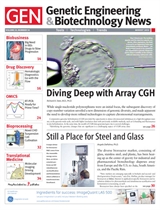Sep 10 2013
Scientists have developed a synthetic molecule, a protein domain mimetic, that may slow cancer. The synthetic molecule, which is called HBS 1, appears to work by disrupting oncogenic signaling, thereby arresting tumor growth. Specifically, HBS 1 targets the interaction of a transcription factor (hypoxia-inducible factor-1α) with a coactivator (p300/CBP). The scientists, reporting in the Proceedings of the National Academy of Sciences, wrote, "Our results indicate that disrupting this interaction results in a rapid down-regulation of hypoxia-inducible genes for cancer progression."
The targeting of transcription factor-coactivator interfaces differs from the typical search for small molecules that target cellular kinases. Accordingly, it may represent a new frontier in cancer research.
The PNAS report was based on work completed by the research groups of Paramjit S. Arora, a professor in NYU's Department of Chemistry, and Bogdan Z. Olenyuk from the School of Pharmacy, University of Southern California, Los Angeles. These groups worked with renal carcinoma cells in murine xenograft models. The results of their in vivo experiments, however, may be applicable to many human conditions, including other cancers, cardiovascular diseases, and diabetic complications.
The general concept of the study - the interruption of the connection between genes as they conspire to promote cancer growth - is applicable to the protein-protein "conversations" implicated in a host of human diseases. The protein interaction of interest in this study controls expression of genes under hypoxic environments, such as those found inside tumors. (As noted in the study, the low-oxygen conditions promote antiogenesis, the process of formation of new blood vessels, that together with invasion and altered energy metabolism facilitates tumor growth.)
In the study, HBS 1 was shown to disrupt the cancer cell signaling network, reaching the correct target in the cell to provide a rapid blockade of tumor growth. Importantly, the compound did not show any signs of toxicity or negative impact in the test host.
The investigators noted that the blockade of gene expression was selective: "Gene expression profiling with oligonucleotide microarrays revealed effective inhibition of hypoxia-inducible genes with relatively minimal perturbation of nontargeted signaling pathways."
Putting their work in context, the investigators wrote, "Selective blockade of gene expression by designed small molecules is a fundamental challenge at the interface of chemistry, biology, and medicine. Transcription factors have been among the most elusive targets in genetics and drug discovery, but the fields of chemical biology and genetics have evolved to a point where this task can be addressed."
HBS 1 is based on chemically stabilized secondary structure of a protein that is mimicking a specific fold, called α-helix. This compound was specifically designed to interrupt cell signaling that promotes growth of cancer cells. Creation of HBS 1 required a method for locking correct helical shapes in synthetic strings of amino acids - a method previously developed at NYU.

 This article was reprinted from Genetic Engineering & Biotechnology News (GEN) with permission from Mary Ann Liebert, Inc., publishers. Genetic Engineering & Biotechnology News (GEN) has retained its position as the number one biotech publisher around the globe since its launch in 1981. GEN publishes a print edition 21 times a year and has additional exclusive editorial content online, like news and analysis as well as blogs, podcasts, webinars, polls, videos, and application notes. GEN's unique news and technology focus includes the entire bioproduct life cycle from early-stage R&D, to applied research including omics, biomarkers, as well as diagnostics, to bioprocessing and commercialization.
This article was reprinted from Genetic Engineering & Biotechnology News (GEN) with permission from Mary Ann Liebert, Inc., publishers. Genetic Engineering & Biotechnology News (GEN) has retained its position as the number one biotech publisher around the globe since its launch in 1981. GEN publishes a print edition 21 times a year and has additional exclusive editorial content online, like news and analysis as well as blogs, podcasts, webinars, polls, videos, and application notes. GEN's unique news and technology focus includes the entire bioproduct life cycle from early-stage R&D, to applied research including omics, biomarkers, as well as diagnostics, to bioprocessing and commercialization.